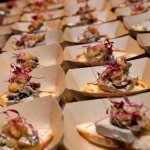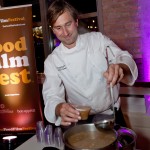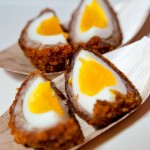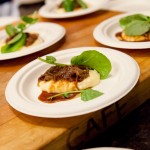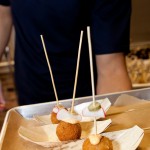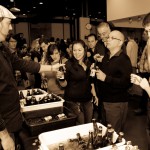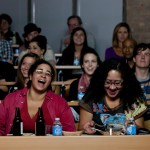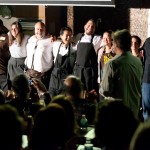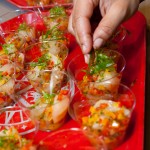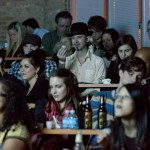I took the number eight bus all the way to Goose Island, a charming little slice of land in the north branch of the Chicago River with the spiritual resonance of the detritus surrounding an airport. It was once heavily industrialized, with breweries, tanneries, and soap factories occupying its minimal acreage. On the southern end of the island sits Kendall College, which rises clean and modern in the shadow of the Willis Tower and in stark contrast to the hulking elevators and storage silos across the sliver of water from it, and where, five stories above Goose Island, a particular assortment of people gathered for the final night of what may be the most critically aware congregation ever assembled.
“Congregation” is a purposeful choice of words, for the two kinds of people who are most attracted to the Food Film Festival, in its third year in Chicago, are cineasts and foodies, both of whom adore their particular expression of humanity and culture with a zeal that borders on fanatical. The theater was structured like the wall of a ziggurat, tiered floors with long, communal tables ascending up and away from a kitchen above which hovered the three screens that the night’s films would be screened upon. Well-heeled patrons sipped on a selection of beers chosen by the event’s “beer sommelier” and enjoyed samples of food from the kitchen.
Related Posts
I chose a place alongside the great tables roughly three-quarters of the way up the temple steps, and was soon joined by a long, lean young lady with a pile of onyx curls atop her head wearing a loose-knit heather sweater and dark denim. Noticing the press pass dangling across her chest, I asked her who she was here with. “Zagat,” she replied. I explained to her that I was predominantly a music writer, and asked about these people surrounding us, about who would come to this event.
“It’s like a cult,” she said, explaining the importance of food to those gathered here. She was there to write about the food itself as much as the films, and I pressed her on whether anyone of great import in her world was in attendance. “It’s a bigger deal in New York City,” she ruminated, before ratting off a minor listing of notable people who were in attendance, which included the highly regarded Tribune journo Rick Kogan and NBC’s Cat Greenleaf, who was insufferable as emcee for a portion of the evening. After finding out that she writes about food for a living — “I’m not sure I could do it without so many comped meals” — I admitted that I had never thought of Chicago as much of a gourmet city. She seemed slightly taken aback by the comment. “Don’t tell people that,” she said under her breath.
There are two things that immediately struck me about foodie culture: one is the electric undercurrent of sexuality that permeates it; the other is the vicariousness with which these people partake in something that most of us do everyday with little more than a second thought. Of the two observations, the second one is perhaps more easily explained, and is a direct causation of the first. The foodie is so intrinsically connected with their passion because, unlike the music lover or art watcher or theatergoer, who interacts with their chosen forms on a deeply spiritual, intellectual, and emotional level, the gourmet can carry all of those aforementioned connections while at the same time literally becoming one with what they adore. They do not simply see the food, or touch, smell, critique, and pontificate upon it. They physically take it into themselves, and it is this primal and direct connection that causes them to audibly gasp at images of food onscreen, or to chant “hickory smoked Jarlsberg” — a cheese that was being premiered that evening in what, I suspect, is the foodie’s equivalent to the debut of a new album or fall line or art installation in terms of excitement and importance — when prompted. This physical joining is intimate; it takes place on the tongue, on the lips, in delicate bites and sips, and deep, aromatic inhalations, and that is perhaps to blame for the lustful side of the culture.
Food is explored in the same way as a lover, and expressions of that sentiment are found in ways both obvious, such as in the tongue-in-cheek nomenclature of “food porn,” and in ways far deeper. People gathered close to partake in the delicacies offered them, and physical contact, be it as obvious as placing food in another’s mouth, holding hands, or caressing the shoulder blades while sipping wine, or as subtle as fingertips brushing when passing along the samples, ran rampant amongst the finely attired crowd.
Food porn is aptly named, as cameras caress and linger upon artfully composed images of food, which, sans plot, character, or drama, is in and of itself the sole reason for the filming, about as fine an example of pornographic material — material whose main goal is pleasuring the id — as one can find, and one to which the audience reacts to in much the same way as it would pornography in the common sense. Even imagery not expressly made for titillation treats the food and the processes that make it, the cutting, stretching, kneading, crushing, boiling, grinding, cooling, breathing, dripping, running, like the visual arts treat the female form. An ad for cheese that ran prior to the films featured shots of fondue so lovingly framed as to be almost iconic, and prominently featured a close-up of a patron licking a last bit of the canary yellow goo from her lips.
The evening’s explicit porn selection was Benevolent Butcher: Bacon, a piece whose imagery of thick cuts of phallic meat was not nearly as heavy handed as it sounds on paper. The audience gasped and moaned with each new angle, and a climactic scene of a toothpick penetrating the bacon and meat it was wrapped around was one of the more beautifully rendered Freudian psychosexual vignettes of the evening. Served with in conjunction with the film — see it, eat it — the bacon dish was chewy and flavorful, served with a dark sauce that nipped exceptionally well at the tongue.
In direct juxtaposition to Benevolent Butcher was Food Porn, which pushed the boundary past the libido and into the absurd. Starring Larry Cauldwell, the food porn star, the film featured images of a kohl-eyed, ruby-lipped woman feeding food into Larry’s fantastically mustached mouth, bouncing from the admittedly alluring images of her enjoyment, to the physical comedy of just how many chocolate strawberries or whipped cream-covered bananas could Larry swallow, anyhow? In a similar vein, but bent decidedly more towards humor, was Vegetables: Friend or Foe?, a piece that laid out, in full Reefer Madness regalia, the inherent evils of “Hell’s apples,” the tomato.
The main event was a screening of Whisky: The Islay Edition, which explored the Scottish island’s internationally known brand of spirits, and was accompanied by a tasting of offerings from all eight of the island’s distilleries. The film itself was strikingly pretty, combining an overwrought, high-gloss production value with the naturally abundant beauty of Islay itself and riding that balance between laboratory white screens, upon which the whisky was laid out and lovingly posed, and the organic greens, browns, and striking blues of the landscape from which it came.
Visuals aside, the film was poorly written, a highfalutin and masturbatory act of worship more than a documentary, which was stronger when its tongue was removed from its cheek and was spent discussing the physical processes of tasting and distilling whisky and the effects the island’s geography and culture have on the finished products (and vice versa) than when describing the spirits as “explosive” or “dark black” or of being “creamy in the mouth” — the sexual connotations of which are not exactly subtle — or when utilizing a most favorite term, “peaty.” The over-reliance on the word “peat” is in and of itself not a crime; the substance is integral to the island’s whiskys, and its flavor is indeed the most distinct thing about them. Still, it becomes almost a running joke by the midway mark; if we were to partake of the whisky every time the word was uttered, no one would leave the screening alive.
Far better than the film were the whiskys themselves, which lack the dark, wooden taste of so many American bourbons and the smooth, polished flavor of the blended Canadians (which are my personal favorite), instead giving hints of sea salt and, yes, peat. Of the eight offered to us, Bowmore, Bunnahabhain, and Kilchoman left the greatest impressions upon me. Bowmore was most like a Canadian, incredibly smooth and palate-coating, with an aftertaste that was desirable in and of itself. Bunnahabhain has a similarly gentle nature, but was sweeter than the Bowmore, while the Kilchoman tingled the lips and tongue in a shocking and enjoyable way.
After the screening, guests were treated to an after party, where a wide array of dishes, including smoked salmon morsels wrapped around some sort of filler, various dessert pies, and Larry Cauldwell’s sweet and salty nuts awaited them, as well as more beer, wine, and whisky selections. I stuck around for a while, sipping on a dark, smoky beer with hints of caramel and chocolate that I was enjoying, much to the disappointment of the beer sommelier, sans the new flavor of Jarlsberg cheese. Watching the foodies laugh and love together in one massive gourmet orgy in the sky, I could understand the appeal of their world, even though I did not desire to make it my own, and soon found myself slipping away to the windows to look out at the Willis Tower, thrusting heavenward, pockmarked by lights and colors and ending in twin gleaming white fangs.
On my way out, I caught the eye of the Zagat writer. She gave me a nod and a smile, which I returned, before waiting again for the number eight bus, the tingle of whisky still on my tongue.
—
B. David Zarley is a freelance writer based in Chicago. You can find him on Twitter @BDavidZarley or at the Gingerman Tavern on any given night.
